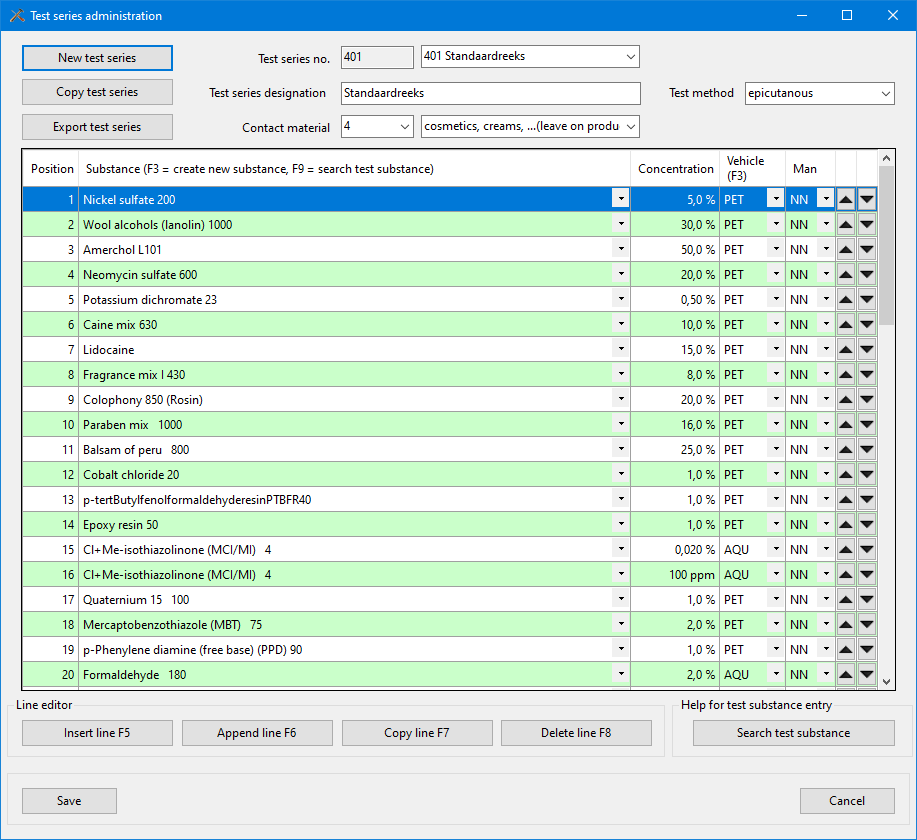Test series administration
Test series administration
This menu item enables the addition of new and the modification of existing clinic test series (synonym: clinic blocks). The work required for this is carried out with the help of the drop-down menu "Utilities", Test series administration".
•Clinic blocks: are all test series that are not only tested on a single, specific patient. The test type (epicutaneous, rubbing, prick test) can be determined here, test substances can be added or deleted. The concentration, the vehicle and the manufacturer can be changed.
•Function/button "Copy block": eases the effort when creating new blocks if only the test type changes. In addition, the paperwork is reduced if, for example, a substance is to be tested in different concentrations.
•Function/button "Export block": gives you the option of exporting the current block to a text file for further processing.
The screen shot shows the administration of an epicutaneous test series. The entry and
administration of type 1 test series is possible as well as that of type 4.
•Be careful not to change an existing test block, i.e. create a new version of it, as long as it is still being used, i.e. tested on any patients, and the relevant results are not yet stored in the database.
•If a test block is changed, which may be necessary from time to time to add new substances, remove substances, change the concentration, the vehicle or the manufacturer of an allergen, the old version will only be available for "old" cases but not for reading current or future cases.
•Therefore, enter all data obtained with a particular test block before changing it.
•Test blocks can be used for tests as long as they are valid. After a test block has been modified or deleted, no new tests can be performed with this block. Tests that have been started can be terminated (e.g. you have tested a block after 24h and then changed it. You can then enter the values for the later reading, e.g. 48h, but it is not possible to create a new patient with the old block).
•The test results are all kept historically correct, so that changing a block does not affect old results; they are always printed correctly in the test protocol or analysed correctly in the reports on the test results.
•Great care should be taken when searching the database for substance names. Synonyms and spelling variants must be taken into account, as multiple entries for the same substance should be avoided.
•Data that can be entered for a test substance:
•Substance - i.e. name of allergen, concentration (%), test vehicle ( AQU, VAS, etc.), manufacturer of test substance (NN=No information).
Search the substance list carefully for substances already stored in the database before adding a new substance name!
•Searching the database for substance names must be done with special care. Synonyms and spelling variants must be considered to avoid multiple entries of a certain substance. Enter some letters of the (test) substance in the test substance selection list (dropdown) and select the appropriate substance.
•Note the special importance of the function keys F9 for searching (test) substances. s. Keyboard
•If you do not find the appropriate allergen, please select the 1st element ((new substance)) in the test substance selection list (dropdown) or press the F3 function key to open the dialogue for creating a substance. In the case of cosmetics, it is also possible to enter the INCI name.
•Alternatively, you can activate a test substance search with the button Search test substance (bottom right in the dialogue) or F9. This dialogue also allows the creation of a new test substance in case the search and filtering for a substance name was unsuccessful.
Administrative functions: List of test substances and test series:
•Under the menu item Utilities, Test substance list Test series, Test substance list with filter, Test series overview are available. You can print out the list of (filtered) test substances or test series and make it available to the staff as a working aid. The test substance list provides information on the concentration, the vehicle, the block number and the position of a substance within the test series in which it occurs.